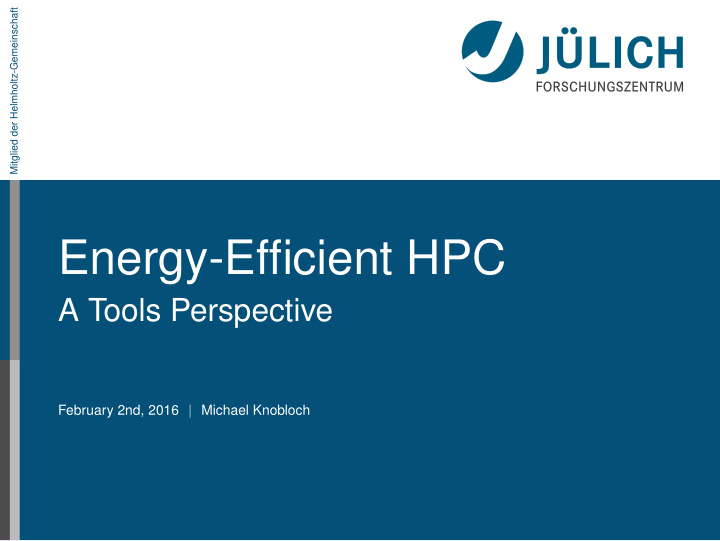



Mitglied der Helmholtz-Gemeinschaft Energy-Efficient HPC A Tools Perspective February 2nd, 2016 Michael Knobloch
Short Intro to Performance Tools Trigger performance data Sampling Code instrumentation Recording performance data Profiling Tracing February 2nd, 2016 Michael Knobloch Slide 2
Sampling February 2nd, 2016 Michael Knobloch Slide 3
Instrumentation February 2nd, 2016 Michael Knobloch Slide 4
Instrumentation Techniques February 2nd, 2016 Michael Knobloch Slide 5
Instrumentation Critical Issues February 2nd, 2016 Michael Knobloch Slide 6
Profiling February 2nd, 2016 Michael Knobloch Slide 7
Tracing February 2nd, 2016 Michael Knobloch Slide 8
Tracing details February 2nd, 2016 Michael Knobloch Slide 9
Tracing vs. Profiling February 2nd, 2016 Michael Knobloch Slide 10
Energy-Efficiency Tools Projects at JSC Score-E February 2nd, 2016 Michael Knobloch Slide 11
eeClust – 2009 - 2012 eeClust - Energy-Efficient Cluster Computing Project partners: Uni Hamburg, TU Dresden, JSC, ParTec www.eeclust.de Goals: Identify phases of low resource utilization and turn hardware to lower power-states in such phases Integral point: Extension of performance analysis tools to analyse application power consumption and hardware utilization February 2nd, 2016 Michael Knobloch Slide 12
MPI Busy-Waiting MPI Busy-Waiting Power consumption in phases of busy-waiting is very high due to constant CPU activity. February 2nd, 2016 Michael Knobloch Slide 13
Scalasca Workflow Measurement library Distributed trace Instr. target application Parallel Wait-state Report wait-state report browser search February 2nd, 2016 Michael Knobloch Slide 14
Scalasca Wait-State Detection processes A Send B Recv C Send D Recv Wait State time February 2nd, 2016 Michael Knobloch Slide 15
Calculating Energy-Saving Potential Idle-Waiting ESP = max p ∈ PS (( t w ∗ A p 1 ) − ( t w − t T p , p 1 ) ∗ I p + E T p , p 1 ) Busy-Waiting ESP BW = max p ∈ PS (( t w ∗ A p 1 ) − ( t w − t T p , p 1 ) ∗ A p + E T p , p 1 ) PS – Set of power states t w – Waiting time A p – Active energy in P-State p t T p 1 , p 2 – Transition time I p – Idle energy in P-State p E T p , p 1 – Transition energy February 2nd, 2016 Michael Knobloch Slide 16
Example: Energy Saving Potential February 2nd, 2016 Michael Knobloch Slide 17
Example: Optimal P-State Detection February 2nd, 2016 Michael Knobloch Slide 18
EIC – 2010 - . . . EIC - Exascale Innovation Center Project partners: IBM Germany R&D and JSC Goal: Co-Design for next-gen of Supercomputers One work-package on energy-efficiency Investigation of power consumption on Blue Gene Fine-grained power measurements on POWER7 Now in transition to PADC - POWER Acceleration and Design Center February 2nd, 2016 Michael Knobloch Slide 19
Power Consumption Analysis on POWER7 Amester IBM Automated Measurement of Systems for Temperature and Energy Reporting software. Results were published at EnA-HPC 2013. Sensor name Units Time scale Description PWR1MS W Instantaneous Node power consumption PWR1MSP0 W Instantaneous Processor power consumption PWR1MSMEM0 W Instantaneous Memory power consumption PWR32MS W avg. over last 32 ms Node power consumption PWR32MSP0 W avg. over last 32 ms Pocessor power consumption PWR32MSMEM0 W avg. over last 32 ms Memory power consumption IPS32MS Mips Every 32 ms Instructions per second rate February 2nd, 2016 Michael Knobloch Slide 20
Example: Component Level Power Measurement February 2nd, 2016 Michael Knobloch Slide 21
Example: Counter Resolution Comparison February 2nd, 2016 Michael Knobloch Slide 22
Amester on POWER8 200 150 Power ( W ) 100 50 0 20 40 60 80 100 Time ( s ) Disk IO Memory GPU Fan CPU February 2nd, 2016 Michael Knobloch Slide 23
Score-E – 2013 - 2016 Score-E Main Tools Partners: JSC, TU Dresden, TU Munich Successor of SILC and LMAC Extension of Score-P measurement system (www.score-p.org) Common measurement system for Scalasca, Vampir, and Periscope Power and Energy measurements from different sources, e.g. RAPL, Xeon Phi/GPU power sensors, etc. Energy modelling from power consumption data Enable auto-tuning for energy efficiency New visualization based on application geometries February 2nd, 2016 Michael Knobloch Slide 24
Lessons learned Metric discussion Still on the quest for the right metric Power vs. Energy Might require different analyses User motivation (still) hard Tools need Sensors that provide relevant information Power, energy, temperature, etc. At all relevant system levels Scalable APIs February 2nd, 2016 Michael Knobloch Slide 25
Discussion: Road to Dark Silicon Challenges for tools How reliable is performance data from dynamic applications? How reliable is performance data on dynamic hardware? How to analyse dynamic applications? Requirements on tools ? February 2nd, 2016 Michael Knobloch Slide 26
Recommend
More recommend